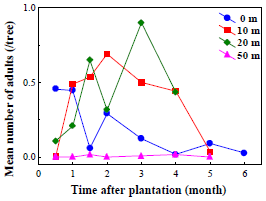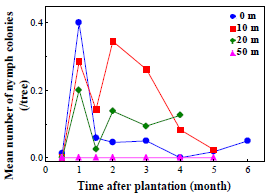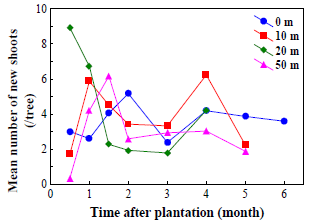Invasion of citrus psyllids in rehabilitated orchards and its probability decreased with distance of the new orchard from adjacent long-established ones
Description
Citrus greening disease (referred to as CG hereinafter), or Huanglongbing, is currently one of the most serious problems facing citrus farmers worldwide, since it results in destructive damage to citrus production only a few years after its invasion. There is no decisive control method for this disease. The most practical management considered at this moment is the combination of removal of all rutaceous trees in and around orchards, planting new disease‑free seedlings, and application of systemic insecticides thereafter. The success of this method appears to be primarily and strongly dependent on the re‑invasion of viruliferous psyllids of the orchard after its sanitation. We can expect a negative correlation between the probability of re‑invasion and the distance of the new orchard from the nearest old orchard. Knowing this correlation a priori, we can predict the risk of disease occurrence through the invasion of vectors in new orchards. If we use insecticides only when or where the risk is predicted to be high, it will help to reduce the use of pesticides or enable their more effective and rational use.
We examined the above hypothesis using four orchards in the Mekong Delta Region of southern Vietnam, varying their distances from the nearest old orchard from 0 to 50 m. We planted disease‑free seedlings of king mandarin in May to June 2005. We will propose more efficient and economic control of psyllids for new orchards based on our results.
The probability of invasion of new orchards by psyllids was dependent on the distance of the new orchard from the nearest old one. Orchards which were at a distance of 20 m were heavily invaded by psyllids two weeks after planting, with mean densities (adults/tree) generally from 0.1 to 0.9 (Fig. 1).
Many first-generation nymphs appeared within one month of planting these orchards. The maximum density of nymphs reached 0.4 colony/tree in one orchard (Fig. 2).
On the other hand, an orchard 50 m distant from the nearest old orchard was rarely invaded by psyllids, and the time of the first invasion was delayed for one and half months (Figs. 1, 2). No nymphs were found throughout the study period (6 months).
Psyllids use new shoots as feeding and egg‑laying sites. However, the numbers of new shoots were not apparently different between the studied orchards (Fig. 3), indicating that the re‑invasion of psyllids depended on the distance of the new orchard from the nearest orchard.
In orchards within 20 m of the nearest old orchards, the population density of psyllids reached more than 0.2 adult/tree in one month and maintained this high density for three to four months. Accordingly, the densities of nymph colonies were likely to be high during these months. Thus, if some trees are infected with the CG pathogen vectored by invading adult psyllids, the pathogen will be rapidly transmitted by adults that had developed from nymphs on the CG-infected trees at high frequency, with the result that CG will be quickly spread throughout the orchard. Hence, to prevent a second dissemination of the pathogen, control of psyllids in these orchards should be undertaken immediately after they are planted.
Both the latency to the occurrence of the first invasion and the frequency of psyllid invasion may be determined not only by the distance but also the season of planting, cultivation system, geographical situation of the orchard, vegetation in or around the orchard, and so on. These factors remain to be examined.
Figure, table
-
Fig. 1. Change in the number of psyllid adults in citrus orchards at different distances from the nearest old orchard after planting seedlings. -
Fig. 2. Change in number of psyllid nymph colonies in citrus orchards at different distances from the nearest old orchard after planting seedlings. -
Fig. 3. Change in number of new shoots in citrus orchards at different distances from the nearest old orchard after planting of seedlings.
- Affiliation
-
Japan International Research Center for Agricultural Sciences Okinawa Subtropical Station
- Term of research
-
FY2005(FY2004~2008)
- Responsible researcher
-
ICHINOSE Katsuya ( Okinawa Subtropical Station )
DIEN Le Quoc ( Southern Fruit Research Institute )
TUAN Do Hong ( Southern Fruit Research Institute )
- ほか
- Publication, etc.
-
Ichinose, K. (2006) Plant Protection 60(7):302-307
- Japanese PDF
-
2005_seikajouhou_A4_ja_Part21.pdf600.96 KB



